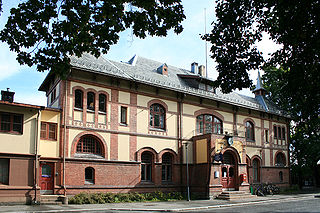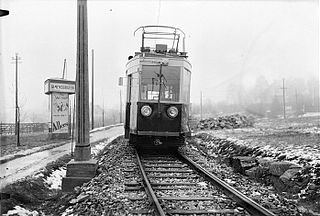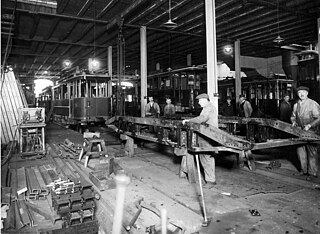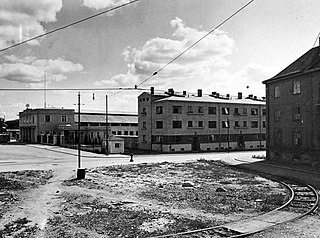| Vålerenga Line | |||
|---|---|---|---|
 | |||
| Overview | |||
| Native name | Vålerenglinjen | ||
| Type | Tramway | ||
| System | Oslo Tramway | ||
| Locale | Oslo, Norway | ||
| Operation | |||
| Opened | 3 May 1900 | ||
| Closed | 23 June 1968 | ||
| Owner | Kristiania Sporveisselskab (1900–24) Oslo Sporveier (1924–68) | ||
| Character | Tramway | ||
| Depot(s) | Vålerenga Depot | ||
| Technical | |||
| Number of tracks | Double | ||
| Track gauge | 1,435 mm (4 ft 8 1⁄2 in) | ||
| Electrification | 600 V DC | ||
| |||
The Vålerenga Line (Norwegian : Vålerengalinjen), also known as Helsfyr Line and Etterstad Line, is an abandoned line of the Oslo Tramway of Norway. It branched from the Gamlebyen Line in Schweigaards gate and ran into the neighborhoods of Vålerenga, Etterstad and Helsfyr. The line followed the streets of Schweigaards gate, St. Halvars gate, Enebakkveien, one direction each in Vålerenggata and Strømsveien, and Etterstadgata. The line continued as a suburban light rail as the Østensjø Line and the Lambertseter Line.
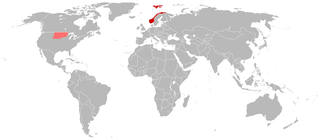
Norwegian is a North Germanic language spoken mainly in Norway, where it is the official language. Along with Swedish and Danish, Norwegian forms a dialect continuum of more or less mutually intelligible local and regional varieties, and some Norwegian and Swedish dialects, in particular, are very close. These Scandinavian languages, together with Faroese and Icelandic as well as some extinct languages, constitute the North Germanic languages. Faroese and Icelandic are hardly mutually intelligible with Norwegian in their spoken form because continental Scandinavian has diverged from them. While the two Germanic languages with the greatest numbers of speakers, English and German, have close similarities with Norwegian, neither is mutually intelligible with it. Norwegian is a descendant of Old Norse, the common language of the Germanic peoples living in Scandinavia during the Viking Era.

Norway, officially the Kingdom of Norway, is a Nordic country in Northern Europe whose territory comprises the western and northernmost portion of the Scandinavian Peninsula; the remote island of Jan Mayen and the archipelago of Svalbard are also part of the Kingdom of Norway. The Antarctic Peter I Island and the sub-Antarctic Bouvet Island are dependent territories and thus not considered part of the kingdom. Norway also lays claim to a section of Antarctica known as Queen Maud Land.

The Gamlebyen Line is a section of the Oslo Tramway which runs east from Jernbanetorget along Schweigaards gate (street), past the Oslo Bus Terminal then turns south along Oslo gate, and past Gamlebyen before becoming the Ekeberg Line. The section is served by lines 18 and 19.
Contents
The line was established by Kristiania Sporveisselskab (KSS) on 3 May 1900. In 1923 the first part of the Østensjø Line, owned by Akersbanerne, opened, as did KSS's Vålerenga Depot was opened. Ownership of the line passed to Oslo Sporveier in 1924. Two years later the Østensjø Line open, but not until 1937, when Bærumsbanen took over operations, was there provided a through service. The Østensjø Line became part of the Oslo Metro in 1966. With the reduction in traffic, the Vålerenga Line was closed on 23 June 1968, as part of a citywide gradual closure of the tramway.
A/S Kristiania Sporveisselskab or KSS, nicknamed the Green Tramway, was an operator of part of the Oslo Tramway from 1875 to 1924. The company was established in 1874 and started with horsecar operations on the Ullevål Hageby Line, Gamlebyen Line and the Grünerløkka–Torshov Line. The network was electrified with in 1899 and 1900, whereby the company was bought by Union-Elektricitäts-Gesellschaft. It delivered new Class U trams. Within a few years the company had also opened the Vålerenga Line and Kampen Line. It took over Kristiania Kommunale Sporveie in 1905, taking over its fleet of Class S trams and the Sagene Ring, the Vippetangen Line and the Rodeløkka Line.
A/S Akersbanerne was a municipal owned company that operated tramways in the former Municipality of Aker in current Oslo, Norway. The company was established in 1917, and opened the suburban Østensjø Line tramway in 1926; it took over the majority ownership of Holmenkolbanen in 1933, that owned the Holmenkoll Line, Sognsvann Line and the Røa Line. Akersbanerne merged with Oslo Sporveier in 1949, following the merger of the municipalities.

AS Oslo Sporveier is a defunct municipal owned company responsible for public transport in Oslo, Norway. It was created in 1924 to take over the city's two private tram companies. In 1927 its started with bus transport, including from 1940 to 1968 trolleybuses. Since 1966 rapid transit and from 1985 water buses have also been operated by the company. It was split into two separate companies in 2006; Kollektivtransportproduksjon took over the operation while Oslo Public Transport Administration was responsible for buying the services, fare regulation and marketing. The latter merged into Ruter in 2008, when the Oslo Sporveier brand was discontinued.


